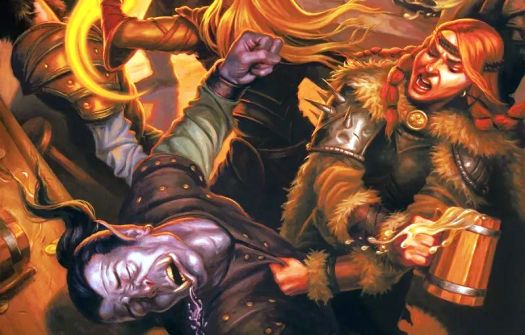Difference between revisions of "Alignment"
Tao alexis (talk | contribs) |
Tao alexis (talk | contribs) |
||
| (2 intermediate revisions by the same user not shown) | |||
| Line 1: | Line 1: | ||
| − | [[File:Alignment.jpg|thumb| | + | [[File:Alignment.jpg|thumb|525px|]] |
| − | I | + | D&D, as I, Alexis play it, does not include the use of alignment in any way, shape or form. |
| − | + | [[Player Characters|Player]] and [[Non-player Characters|non-player characters]] aren't required to subscribe to any definite behaviour, including [[Cleric (class)|clerics]], [[Druid (class)|druids]], [[Thief (class)|thieves]], [[Assassin (class)|assassins]] or [[Paladin (class)|paladins]]. They may kill or harm at will, they may perform good acts, they may do as they like, as any humanoid being might. As such, [[Character Race Relations|humanoid races]] don't conform to a standard either. Any race will have members who are bloodthirsty, kind, generous or malevolent. With regards to behaviour, none of it conforms to those concepts of "good" or "evil" described by alignment. | |
| − | + | Spells which formerly affected evil creatures now affect "malevolent" creatures — those wishing to cause harm, for any reason, as aggressive entities. The former spell, "protection from evil" is now re-imagined as "[[Protection from Malevolence (spell)|protection from malevolence]]." Creatures incapable of personal thoughts, such as those with less than 5 [[Intelligence (ability stat)|intelligence]], are not malevolent ... merely dangerous. | |
| − | There | + | Therefore, anyone might be malevolent, since it's a matter of intention, not nature. |
| − | + | ||
| − | + | There IS such a thing as an evil creature. However, these are limited to unreal manifestations, such as [[Demon|demons]], [[Devil|devils]] and [[Undead|undead]]. Likewise, while "black magic" exists, this describes the intention to use existing magic spells for the purpose of causing harm — a behaviour associated with [[Maleficium|maleficium]]. | |
| − | See [[ | + | |
| + | |||
| + | See [[Character Creation]] | ||
| + | |||
| + | [[Category: Don't Review until 2022]] | ||
Latest revision as of 19:07, 3 October 2021
D&D, as I, Alexis play it, does not include the use of alignment in any way, shape or form.
Player and non-player characters aren't required to subscribe to any definite behaviour, including clerics, druids, thieves, assassins or paladins. They may kill or harm at will, they may perform good acts, they may do as they like, as any humanoid being might. As such, humanoid races don't conform to a standard either. Any race will have members who are bloodthirsty, kind, generous or malevolent. With regards to behaviour, none of it conforms to those concepts of "good" or "evil" described by alignment.
Spells which formerly affected evil creatures now affect "malevolent" creatures — those wishing to cause harm, for any reason, as aggressive entities. The former spell, "protection from evil" is now re-imagined as "protection from malevolence." Creatures incapable of personal thoughts, such as those with less than 5 intelligence, are not malevolent ... merely dangerous.
Therefore, anyone might be malevolent, since it's a matter of intention, not nature.
There IS such a thing as an evil creature. However, these are limited to unreal manifestations, such as demons, devils and undead. Likewise, while "black magic" exists, this describes the intention to use existing magic spells for the purpose of causing harm — a behaviour associated with maleficium.
